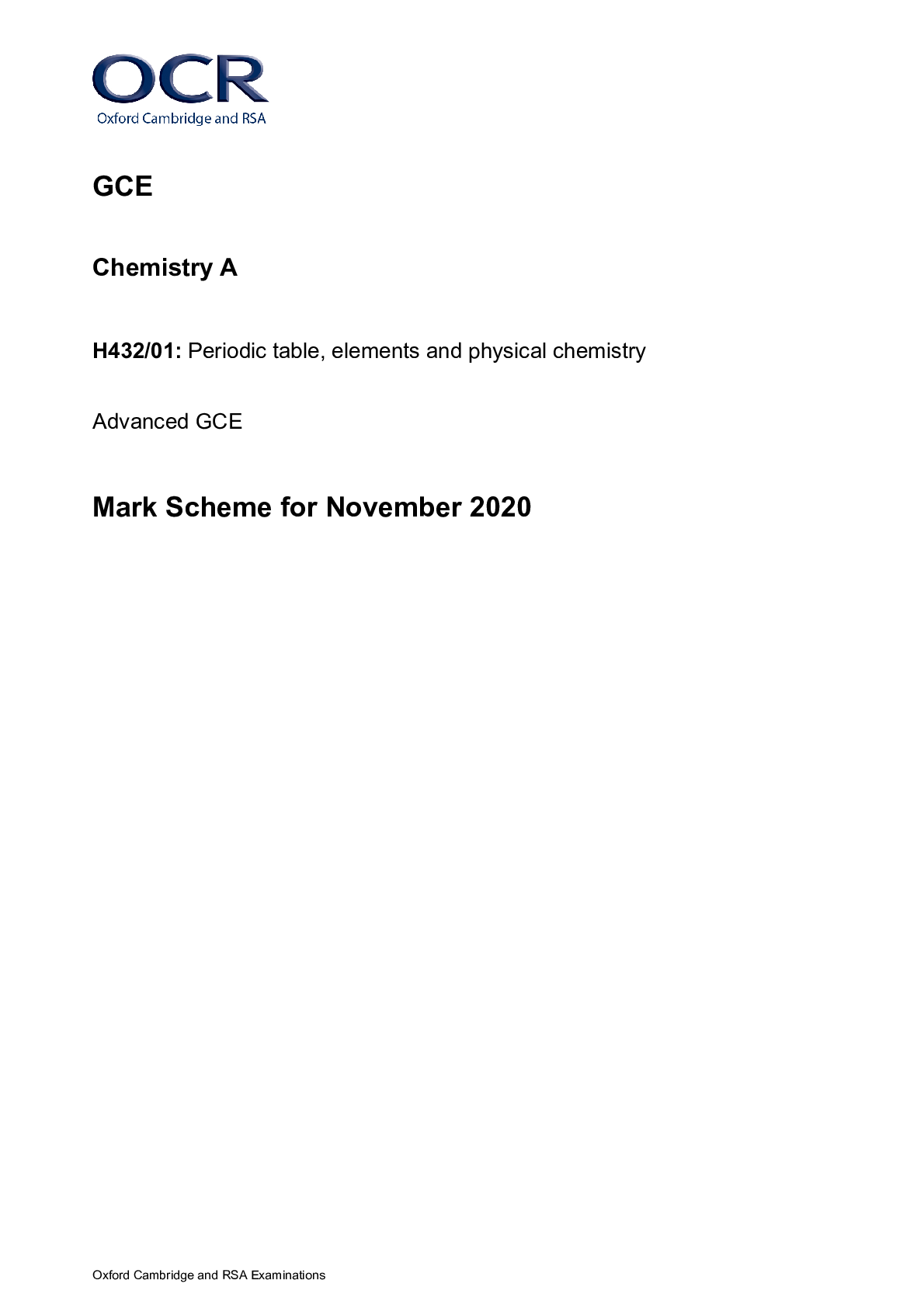History > AS Mark Scheme > GCE History A Y214/01: France 1814-1870 Advanced GCE Mark Scheme for November 2020 (All)
GCE History A Y214/01: France 1814-1870 Advanced GCE Mark Scheme for November 2020
Document Content and Description Below
Oxford Cambridge and RSA Examinations GCE History A Y214/01: France 1814-1870 Advanced GCE Mark Scheme for November 2020Oxford Cambridge and RSA Examinations OCR (Oxford Cambridge and RSA) is a ... leading UK awarding body, providing a wide range of qualifications to meet the needs of candidates of all ages and abilities. OCR qualifications include AS/A Levels, Diplomas, GCSEs, Cambridge Nationals, Cambridge Technicals, Functional Skills, Key Skills, Entry Level qualifications, NVQs and vocational qualifications in areas such as IT, business, languages, teaching/training, administration and secretarial skills. It is also responsible for developing new specifications to meet national requirements and the needs of students and teachers. OCR is a not-for-profit organisation; any surplus made is invested back into the establishment to help towards the development of qualifications and support, which keep pace with the changing needs of today’s society. This mark scheme is published as an aid to teachers and students, to indicate the requirements of the examination. It shows the basis on which marks were awarded by examiners. It does not indicate the details of the discussions which took place at an examiners’ meeting before marking commenced. All examiners are instructed that alternative correct answers and unexpected approaches in candidates’ scripts must be given marks that fairly reflect the relevant knowledge and skills demonstrated. Mark schemes should be read in conjunction with the published question papers and the report on the examination. © OCR 2020Y214/01 Mark Scheme November 2020 2 Annotations Annotation Meaning of annotation Blank Page Highlight Off-page comment Assertion Analysis Evaluation Explanation Factor Illustrates/Describes Irrelevant, a significant amount of material that does not answer the question Judgement Knowledge and understanding Provenance Simple comment Unclear ViewY214/01 Mark Scheme November 2020 3 Subject Specific Marking Instructions Question Answer Mark Guidance 1 (a) Which of the following was of greater importance in securing Louis Napoleon’s position as emperor of the French in 1852? (i)The personality of Louis Napoleon (ii)The coup of 1851 Explain your answer with reference to both (i) and (ii) • In dealing with the personality of Louis Napoleon answers might suggest that his name won him support after the failings of Louis Philippe • Answers might suggest that he fought a well organised campaign and organised the coup for December 2, the anniversary of Napoleon’s coronation and Austerlitz • Answers might suggest that the influence of newspapers as articles portrayed him in a good light , whilst opposition papers were closed down • Answers might suggest that Napoleon conducted himself sensibly after the 1848 revolution • In dealing with the coup of 1851 answers might suggest that it was essential given the limiting power of the constitution. • Answers might consider the failure of the propaganda campaign to win a two thirds majority to change the constitution • Answers might consider the planning of the coup • Answers might consider the arrest of leading politicians opposed to the coup 10 • No set answer is expected • Judgement must be supported by relevant and accurate material. • Only credit material relevant to ‘the personality of Louis Napoleon’ and ‘the coup of 1851’ • Answers may deal with each factor in turn, then compare them to reach a judgement, or may take a continually comparative approach. Either approach is acceptable. • Knowledge must not be credited in isolation, it should only be credited where it is used as the basis for analysis and evaluation, in line with descriptions in the levels mark scheme.Y214/01 Mark Scheme November 2020 4 (b)* To what extent was the growth of liberal opposition responsible for the fall of the Bourbon monarchy in 1830? • In arguing that the growth of liberal opposition was responsible it might be argued that they wanted to move towards a system of parliamentary monarchy. • Answers might consider the desire to reduce the influence of the King in day-to-day politics • Answers might consider the growing support for liberals following the appointment of ministers such as Polignac • Answers might consider that the liberals were concerned that Charles would subvert the Charter • Answers might consider that attacks on the ministry were seen as attacks on the monarch and that to remove the ministers might have to remove the King. • In arguing that that other factors were responsible it might be argued that the economic problems, such as the recession since 1826 were crucial. • Answers might consider how unemployment and price rises and bread shortages led to unrest • Answers might consider the credit crisis which led to bankruptcies • Answers might consider that the religious policies of Charles X created fear • Answers might consider the impact of Ultras • Answers might consider the impact of the press and censorship • Answers might consider the manipulation of the electoral system and the Four Ordinances 20 • No set answer is expected • At higher levels candidates will focus on extent but at level 4 may simply list factors. • At Level 5 and above there will be judgement as to the extent. • At higher levels candidates might establish criteria against which to judge the extent. • To be valid judgements, claims must be supported by relevant and accurate facts. If not they are assertions. • Knowledge must not be credited in isolation, it should only be credited where it is used as the basis for analysis and evaluation, in line with descriptions in the levels mark scheme.Y214/01 Mark Scheme November 2020 5 2 (a) • Answers might consider the influence of Paris and the mob Which of the following was the greater problem facing Louis XVIII in the period from 1814 to 1824? (i) The legacy of Napoleon Bonaparte (ii) The actions of the Ultras Explain your answer with reference to both (i) and (ii). • In dealing with the legacy of Napoleon Bonaparte answers might suggest that many in France associated Napoleon with military success • Answers might suggest that the Bonapartists were not an organised group and therefore not a threat • Answers might consider that even after his death there was widespread sympathy for his cause • Answers might consider that there were members of his family willing to carry on his cause, particularly as Louis had been brought in ‘on the allies baggage train’ • In dealing with the Ultras answers might suggest that they wanted to undermine the Charter • Answers might suggest that their support for Divine Right was a threat to the gains of the revolution • Answers might suggest that their support for the restoration of Church lands was a threat to those who had gained them • Answers might suggest that their support for the restoration of lands taken from the aristocracy was a threat • Answers might suggest that their support for the destruction of parliamentary institutions which they 10 • No set answer is expected • Judgement must be supported by relevant and accurate material. • Only credit material relevant to ‘the legacy of Napoleon Bonaparte’ and the ‘the actions of the Ultras’ • Answers may deal with each factor in turn, then compare them to reach a judgement, or may take a continually comparative approach. Either approach is acceptable. • Knowledge must not be credited in isolation, it should only be credited where it is used as the basis for analysis and evaluation, in line with descriptions in the levels mark scheme.Y214/01 Mark Scheme November 2020 6 (b)* considered an insult to monarchical dignity was a threat to the settlement How far did Napoleon III achieve his foreign policy aims? • In arguing he did achieve his aims, answers might consider the support he won from Catholics by his actions over Rome • Answers might consider that he attempted to restore glory, make France a major power and reverse the subservient foreign policy of Louis Philippe • Answers might consider the support given to Cavour at Plombieres and in war against Austria and in supporting nationalism • Answers might consider the gaining of Nice and Savoy • Answers might consider the gaining of land in Senegal and Indo-China • Answers might consider the success of the Crimean War • In arguing that he did not achieve his aims, answers might argue that he failed to achieve an overseas empire with the failure in Mexico • Answers might consider that he gave offence to the Russians over his support for the Poles in 1863 • Answers might consider the failure of his protests over the Austro-Prussian attack on Denmark • Answers might consider his failure to gain compensation for keeping out of the AustroPrussian conflict 20 • No set answer is expected • At higher levels candidates will focus on assessing how far he achieved his aims but at level 4 may simply list successes and failures. • At Level 5 and above there will be judgement as to how far he achieved his aims. • At higher levels candidates might establish criteria against which to judge whether Napoleon achieved his foreign policy aims. • To be valid judgements, claims must be supported by relevant and accurate facts. If not they are assertions. • Knowledge must not be credited in isolation, it should only be credited where it is used as the basis for analysis and evaluation, in line with descriptions in the levels mark scheme. •Y214/01 Mark Scheme November 2020 7 • Answers might consider his failure over the Hohenzollern candidature and keeping Prussian influence out of Spain • Answers might consider his failure in the war against PrussiaY214/01 Mark Scheme November 2020 8 APPENDIX 1 – this contains a generic mark scheme grid AO1: Demonstrate, organise and communicate knowledge and understanding to analyse and evaluate the key features related to the periods studied, making substantiated judgements and exploring concepts, as relevant, of cause, consequence, change, continuity, similarity, difference and significance. Generic mark scheme for Question 1(a) and Question 2(a): Which of the following? [10] Level 6 9–10 marks Both factors are thoroughly analysed and evaluated using accurate and detailed knowledge and understanding of key features of the period, in order to reach a developed and substantiated judgement in relation to the question. Level 5 7–8 marks Both factors are analysed and evaluated using generally accurate and detailed knowledge and understanding of key features of the period, in order to reach a substantiated judgement in relation to the question. Level 4 5–6 marks Both factors are analysed and evaluated using relevant knowledge and understanding of key features of the period, however treatment of factors may be un-even with analysis and evaluation of one of the two being only partial. Analysis and evaluation is used to support a reasonable judgement in relation to the question. Level 3 3–4 marks Both factors are analysed and evaluated in a partial way, using some relevant knowledge of key features of the period, in order to make a basic judgement in relation to the question. Level 2 2 marks Limited and generalised knowledge of the period is used to attempt a limited analysis or evaluation of both factors, and this is linked to a very simplistic judgement. Level 1 1 mark Very limited and generalised knowledge of the period is used to attempt a very limited analysis or evaluation of one of the factors. The other factor is either not considered or there is very limited information or description of the factor with no attempt to use this knowledge. If there is a judgement, this takes the form of assertion. 0 marks Nothing of any relevance to the factors.Y214/01 Mark Scheme November 2020 9 AO1: Demonstrate, organise and communicate knowledge and understanding to analyse and evaluate the key features related to the periods studied, making substantiated judgements and exploring concepts, as relevant, of cause, consequence, change, continuity,similarity, difference and significance. Generic mark scheme for Question 1(b) and Question 2(b): Essay [20] Level 6 17–20 marks There is a consistent focus on the question throughout the answer. Accurate and detailed knowledge and understanding is demonstrated throughout the answer and is consistently evaluated and analysed in order to reach substantiated, developed and sustained judgements. There is a well-developed and sustained line of reasoning which is coherent and logically structured. The information presented is entirely relevant and substantiated. Level 5 13–16 marks There is a mostly consistent focus on the question. Generally accurate and detailed knowledge and understanding is demonstrated through most of the answer and is evaluated and analysed in order to reach substantiated judgements, but these are not consistently well-developed. There is a well-developed line of reasoning which is clear and logically structured. The information presented is relevant and in the most part substantiated. Level 4 10–12 marks The question is generally addressed. Generally accurate and sometimes detailed knowledge and understanding is demonstrated through most of the answer with evaluation and some analysis, and this is used appropriately to support the judgements that are made. There is a line of reasoning presented with some structure. The information presented is in the most-part relevant and supported by some evidence. Level 3 7–9 marks The question is partially addressed. There is demonstration of some relevant knowledge and understanding, which is evaluated and analysed in parts of the answer, but in places knowledge is imparted rather than being used. The analysis is appropriately linked to the judgements made, though the way in which it supports the judgements may not always be made explicit. The information has some relevance and is presented with limited structure. The information is supported by limited evidence. Level 2 4–6 marks The focus is more on the topic than the specific demands of the question. Knowledge and understanding is limited and not well used, with only limited evaluation and analysis, which is only sometimes linked appropriately to the judgements made. The information has some relevance, but is communicated in an unstructured way. The information is supported by limited evidence and the relationship to the evidence may not be clear. Level 1 1–3 marks The answer relates to the topic but not the specific question. The answer contains only very limited relevant knowledge which is evaluated and analysed in a very limited way. Judgements are unsupported and are not linked to analysis. Relevant knowledge is limited, generalised and poorly used; attempts at argument are no more than assertion. Information presented is basic and may be ambiguous or unstructured. The information is supported by limited evidence. 0 marks No evidence of understanding and no demonstration of any relevant knowledge.OCR (Oxford Cambridge and RSA Examinations) The Triangle Building Shaftesbury Road Cambridge CB2 8EA [Show More]
Last updated: 1 year ago
Preview 1 out of 11 pages
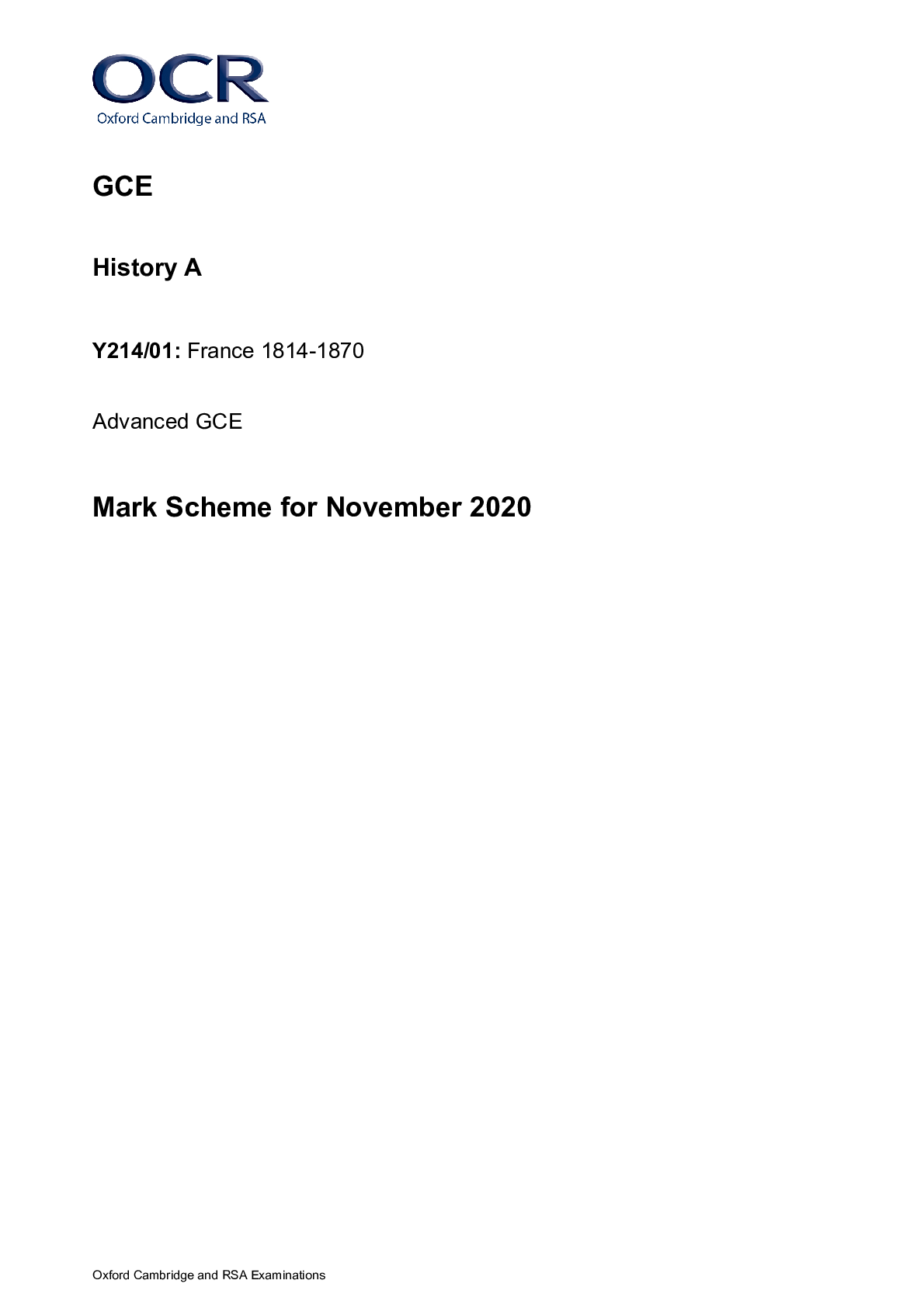
Reviews( 0 )
Document information
Connected school, study & course
About the document
Uploaded On
Oct 10, 2022
Number of pages
11
Written in
Additional information
This document has been written for:
Uploaded
Oct 10, 2022
Downloads
0
Views
27

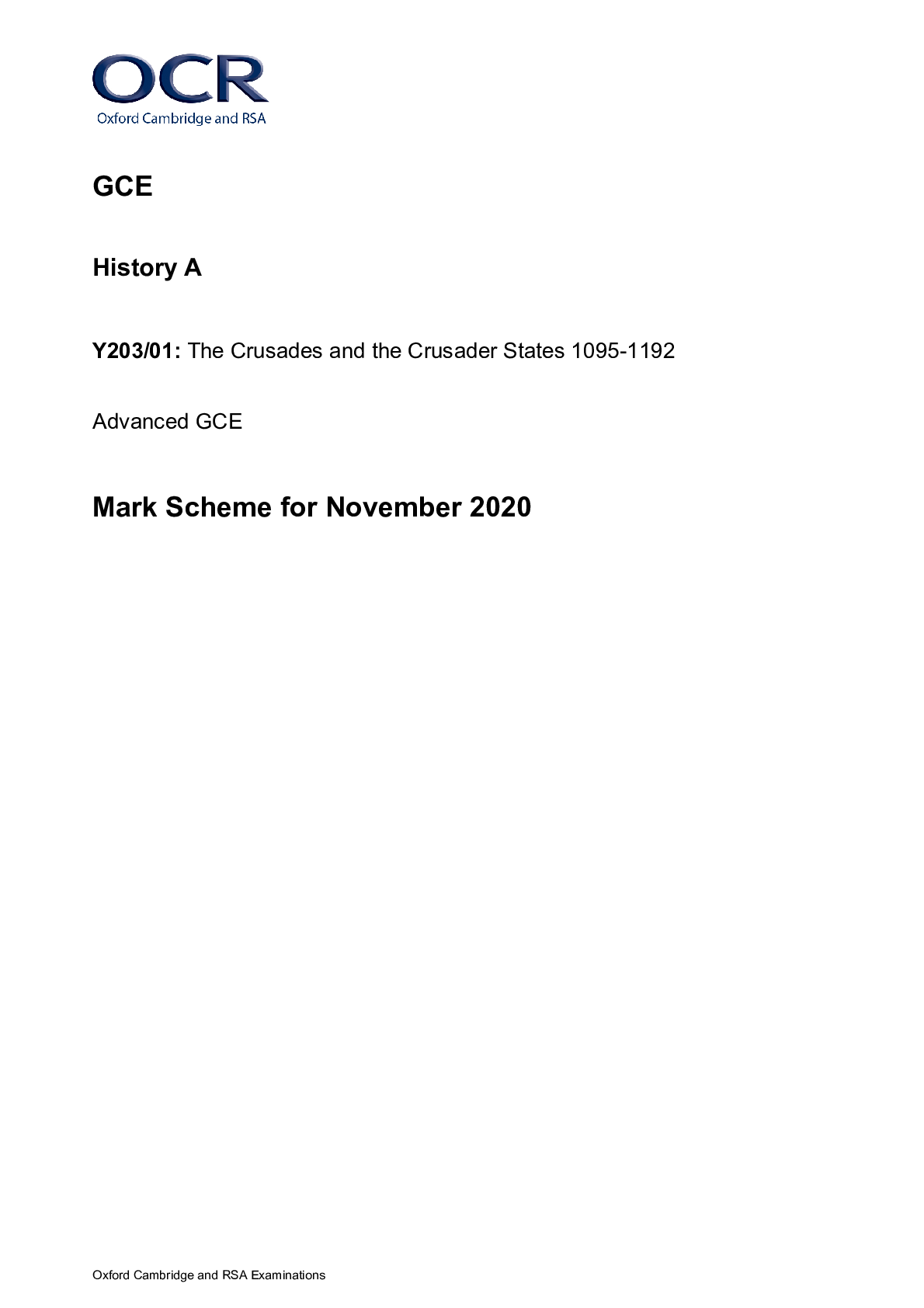
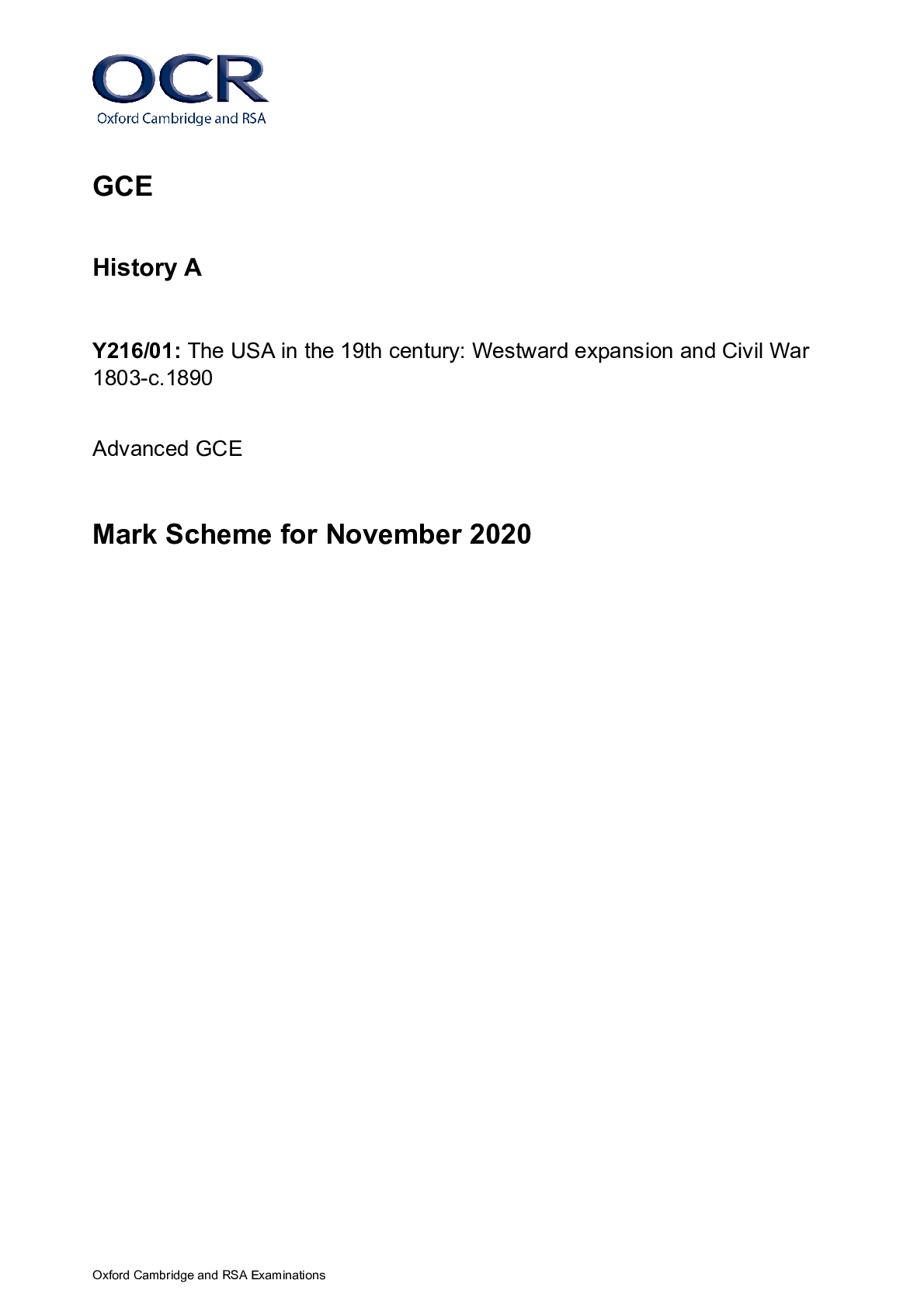



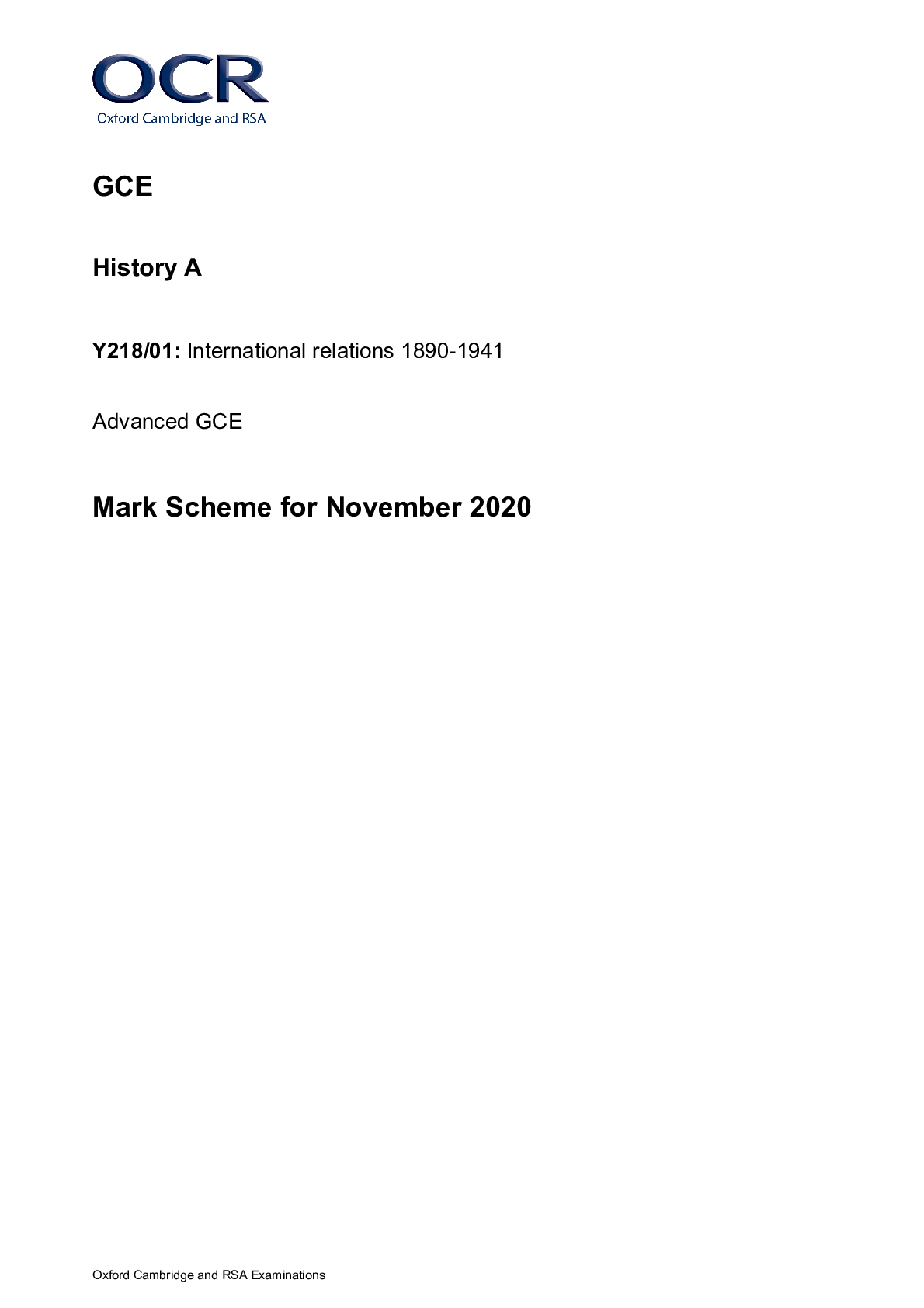
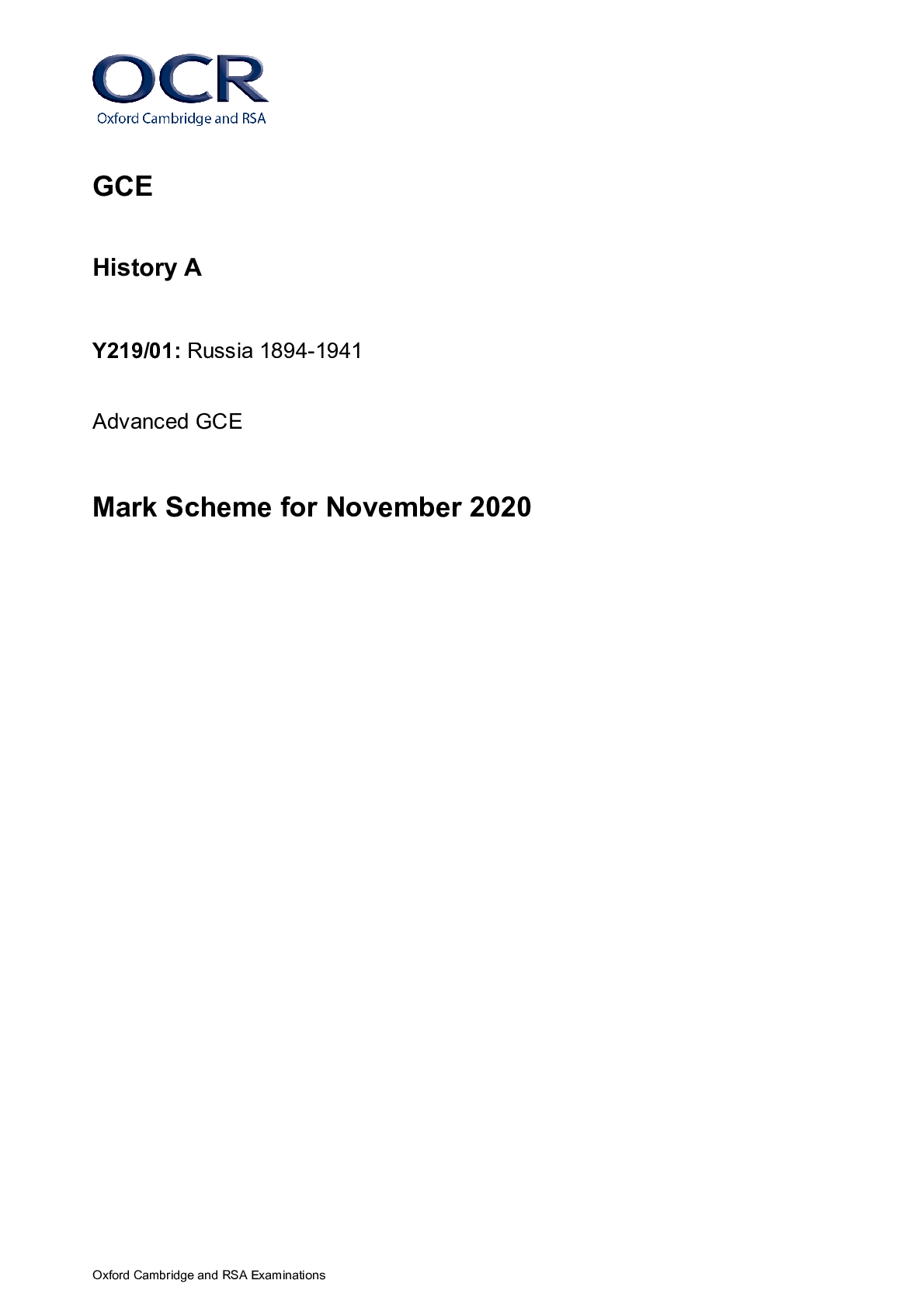







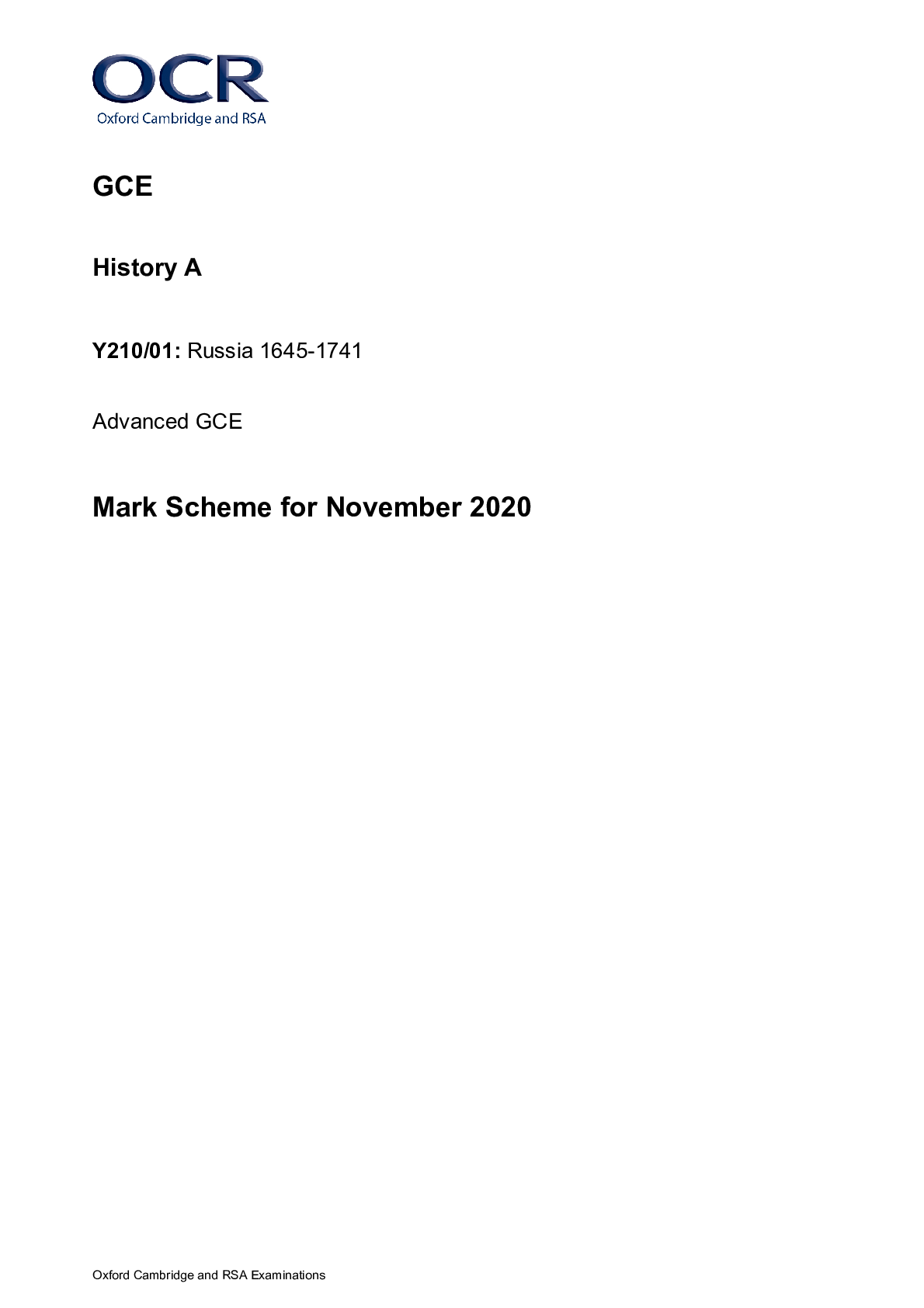


.png)

